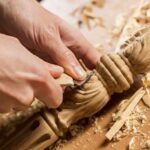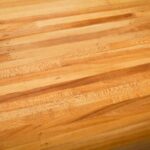Introduction
Beech wood is a popular material for woodworking due to its various benefits. It is strong, strong-grained, lightweight, and has an attractive reddish hue. It takes on finishes quickly and easily, making it perfect for both carving and applying stain or paint. Beech wood is also relatively inexpensive relative to other hardwoods making it an ideal choice for those on a budget. Its hardness makes beech wood excellent for use in furniture and the turning of spindles and other small items. Beech is often used as the mainstay in kitchen cabinetry and flooring due to its strength and dimensionally stability; a quality that can withstand years of wear and tear with minimal signs of damage. Beech has an ability to withstand moisture well so it is suitable for outdoor projects such as garden furniture or other outdoor structures. With its beautiful grain pattern, beech adds a unique look to any finished product.
Characteristics of Beech Wood
Beech wood is a popular choice for woodworking due to its many beneficial characteristics. It is a hard and heavy wood, making it ideal for furniture-making as it can stand up to a lot of wear and tear. Additionally, Beech wood has tight and straight grain patterns, making it visually appealing when working with it or finished products. Beech wood also takes stains very well and is less likely to warp over time than similar woods, meaning that durable results can be achieved in projects that require precision. Finally, Beech wood has a distinctive reddish-brown hue which adds an elegant touch to the product.
Pros and Cons of Using Beech Wood
PROS:
-Beech is a hardwood, making it great for furniture and cabinets that will get lots of use.
-Beech is fairly easy to work with and takes a good finish.
-It looks great when stained or finished with lacquer.
-Beech is a moderately priced wood, making it affordable for most woodworking projects.
CONS:
-This wood can warp easily if not allowed to dry properly before being worked on. A moisture meter should always be used to properly measure the humidity level in the wood before any work begins.
-Beech has a tendency to splinter when cut, which can leave rough edges that require additional sanding or processing before finishing.
Common Applications of Beech Wood
Beech wood is highly valued among woodworkers as it can be used successfully in a wide range of applications. It is a hard, strong, and stiff timber which is perfect for items such as furniture, doors, flooring, kitchen cabinets, and millwork. It is an excellent choice for turning on lathes due to its fine grain, which gives it the ability to absorb details superbly. Furthermore, since beech has high shock resistance qualities it makes it ideal for items such as tool handles and wooden toys. Beech also cuts easily and can take a beautiful finish with oil or lacquer. Lastly, its good gluing properties make beech useful for laminating sections together to create attractive patterns of light and dark stripes. All these features make beech wood an essential material for woodworking projects of all kinds.
Tips and Techniques on Working with Beech Wood
Beech wood is a great choice for woodworking projects due to its high density and impressive straight grain. It’s strong, good for machining and making repeated cuts, and has a tendency not to splinter or chip easily. While the wood takes finishes well, beech also has an attractive natural color.
To get optimal results from beech wood when working with it, follow these tips:
1. Beech is reactive to humidity swings as it is a hygroscopic material. Be sure to condition the wood before use by letting it acclimate to its environment for at least 72 hours before cutting or sanding it.
2. Always use sharp blades when cutting beech in order to get clean, smooth cuts without splintering.
3. To join pieces of beech together, biscuit joints are recommended as they create strong bonds that don’t mar the beauty of the grain.
4. When planing beech, set the depth of your planning blade past the thicker areas of the boards in order to avoid tear-out or strip out errors during operation.
5. When gluing beech parts with glue, make sure that you spread an even layer using a brush because thicker layers can lead to problems after assembly due to possible warping, splitting or bending during drying time
6. Before finishing your project with oil or varnish, ensure that all surfaces are perfectly smooth and free from any marks by sanding them down with increasingly finer grits ” start at about 120 grits and finish up at 220 grits – this procedure will help preserve a nice uniform color over all surfaces permanently
Why Is Beech the Ideal Wood for Woodworking?
Beech wood is an ideal choice for woodworking due to its strong yet lightweight properties. It is a hardwood that has a fine, tight-grained texture, making it highly resistant to dents and scratches as well as splintering or warping. Beech is also less likely than other woods to expand and contract with changes in humidity and temperature, which means it remains stable enough to develop intricate shapes while still having the strength necessary for hard use applications. As it requires little sanding, planing, or jointing beech is often the preferred choice when it comes to creating items with hard angles such as furniture or handles. It is also one of the most affordable hardwoods giving woodworkers the chance to create beautiful projects on a budget. The combination of aesthetics, strength, stability and affordability make beech a great option for anyone looking for high quality woodworking materials.
Final Thoughts
Beech wood is an excellent option for woodworking, especially for beginners. Beechwood is fairly easy to work with due to its strength and resilient nature. Its light and even grains make it great for furniture, cabinets, and decorative pieces. Beech is strong, takes stains well, and can be easily carved or fashioned into intricate designs. Thanks to its hardness, it can also handle the wear and tear of daily use without compromising on looks. Even better, you can usually find a large selection of beech wood at reasonably priced lumber stores.
When utilizing beech wood in your DIY projects, it’s important to ensure that you prepare it properly before starting work; this could include sawing and planing the surface as needed. To help seal the natural color of beech against fading, finishing with multiple coats of lacquer or shellac may be necessary; this will also help keep the wood looking fresh longer. Additionally, you may want to consider adding wax or a light oil after finishing; this helps protect the piece from everyday wear while maintaining its gorgeous deep finish. With proper planning and preparation, creating beautiful wooden pieces with beech becomes much easier indeed!

Hi everyone! I’m a woodworker and blogger, and this is my woodworking blog. In my blog, I share tips and tricks for woodworkers of all skill levels, as well as project ideas that you can try yourself.





